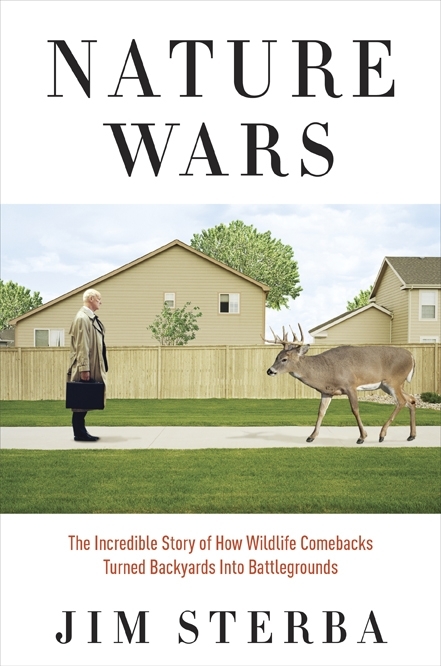The nature-challenged reader will discover many startling facts in Jim Sterba’s new book. One stands out: Not only are America’s Eastern forests roaring back to life, they’ve been doing so for more than a century.
Sterba, a veteran reporter for the Wall Street Journal and The New York Times, literally stumbles onto this truth one day amid the majestic trees of Maine’s Acadia National Park. He sees feral grapevines strangling a birch tree. When he gets out of his car to rip the vines out, he finds a rusting 1927 Maine license plate.
After talking to the locals, Sterba realizes he’s walking on the ruins of a farm that’s been swallowed up by a new forest. The grapes were there before the trees, “a remnant of a very different civilization that had existed not long ago.”
In some of the more densely populated corners of New England, trees have been filling up abandoned farms since the 1850s. Now armies of cute and cuddly creatures are filling up those forests too, including white-tailed deer. So many deer, in fact, as to become odious and obnoxious.
Sterba’s book is a much more sweeping and thoughtful work than its unwieldy and tabloid-sounding title would suggest. At its best, “Nature Wars” isn’t really a book about the conflict between man and nature. Nor is it about the clashes between those who defend nature and those who seek to manage it.
Instead, it’s best read as a history of Americans’ widespread and enduring ignorance of the natural world and how that ignorance has created new and strange ecosystems — especially in our sprawling suburbs and exurbs.
Consider, for example, the weird, epic saga of the largest rodent on the continent, Castor canadensis, otherwise known as the North American beaver. Beavers were wiped out in Massachusetts by frontiersmen and Indian trappers and traders in the early 18th century — they never coexisted with European settlers.
But in 1928 they returned to western Massachusetts as the descendants of 34 beavers from Canada released in the Adirondacks a few decades earlier. Sterba shows how beavers soon thrived in resurgent forests now largely free of their old predators — including humans, no longer interested in slaughtering them en masse for the fur trade. By 1996, the state’s beaver population was estimated at 24,000.
Those beavers now live amid strip malls and golf courses. “People and beavers were sharing the same habitat as never before,” Sterba writes. “They had similar tastes in waterfront real estate. Both like to live along brooks, streams, rivers, ponds and lakes with lots of nice trees nearby.”
Sterba relates the story of the beaver and other troublesome wild creatures with wit and impressive reportorial diligence. He shows us how new suburban residents plant pretty trees in their yards, only to see the beavers chew them down to build dams that flood those yards.
The recent natural history of North America is filled with such stories.
In Sterba’s often amusing narrative, species such as the wild turkey are cast in the role of victims in one era, only to reappear as pests in another.
In “Nature Wars,” Canada geese disappear across the U.S. as their habitat perishes thanks to human development. But they come back thanks to human restoration efforts and to hunters who breed them as live decoys to shoot other birds. Soon much of America from the Great Plains to the Eastern Seaboard is filled with geese.
Unlike their ancestors, many of these modern-day geese refuse to migrate. Why should they? In the ensuing century, Sterba writes, humans had created a goose paradise filled with “soccer fields, playgrounds and parks, all planted in what happened to be the favorite food of Canada geese: grass.”
The geese are pretty to look at and defended by geese lovers — who face off with geese detractors fed up with the birds’ droppings and by their annoying tendency to clog jet engines and cause planes to crash.
One lesson Sterba draws from all this fraught history is that Americans have forgotten how to be stewards of the natural world around them. We Americans don’t understand nature in the same way Sterba did when he was a boy growing up on a Michigan farm in the 1950s.
Sterba conveniently ignores the fact that he grew up during a time when rural people radically altered their environment. Among other things, they sprayed their fields with pesticides that wiped out songbirds and nearly caused the bald eagle to become extinct.
But there’s a lot in “Nature Wars” for the reasoned and concerned human to learn about the changing natural landscape.
Copy the Story Link
Send questions/comments to the editors.



Success. Please wait for the page to reload. If the page does not reload within 5 seconds, please refresh the page.
Enter your email and password to access comments.
Hi, to comment on stories you must . This profile is in addition to your subscription and website login.
Already have a commenting profile? .
Invalid username/password.
Please check your email to confirm and complete your registration.
Only subscribers are eligible to post comments. Please subscribe or login first for digital access. Here’s why.
Use the form below to reset your password. When you've submitted your account email, we will send an email with a reset code.